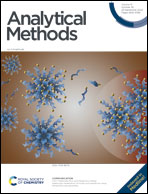Controllable preparation of long wavelength carbon dots and their application in fluorescence detection†
Abstract
By adjusting the reactants and reaction conditions, the particle size and surface state of fluorescent carbon dots (CDs) can be controlled, and CDs with different photoluminescence colors can be finally prepared. However, this multi-step procedure is relatively time-consuming and complex. Therefore, it is of great significance to explore a more convenient and efficient preparation route. In this paper, SA (P-aminobenzenesulfonic acid) and οPD (o-phenylenediamine) were used as precursors, and water and ethanol were used as reaction solvents. By adjusting the proportion of the precursor or reaction solvent, self-doping and co-doping of the precursor were realized, and CDs with various fluorescent colors were finally prepared. It was found that red-emission CDs (r-CDs) could be prepared with SA and οPD as precursors and water as the solvent. Through comparative study, it was found that r-CDs were affected by H+ in the formation process and photoluminescence process. The fluorescence stability of r-CDs indicated that they have good selectivity for some metal ions. The r-CDs prepared in this paper realized the specific recognition of Cu2+ and Ag+ through the “off–on” process, and the detection limits were 0.165 μm and 1.53 μm, respectively. And this test has the potential for practical qualitative testing.



 Please wait while we load your content...
Please wait while we load your content...